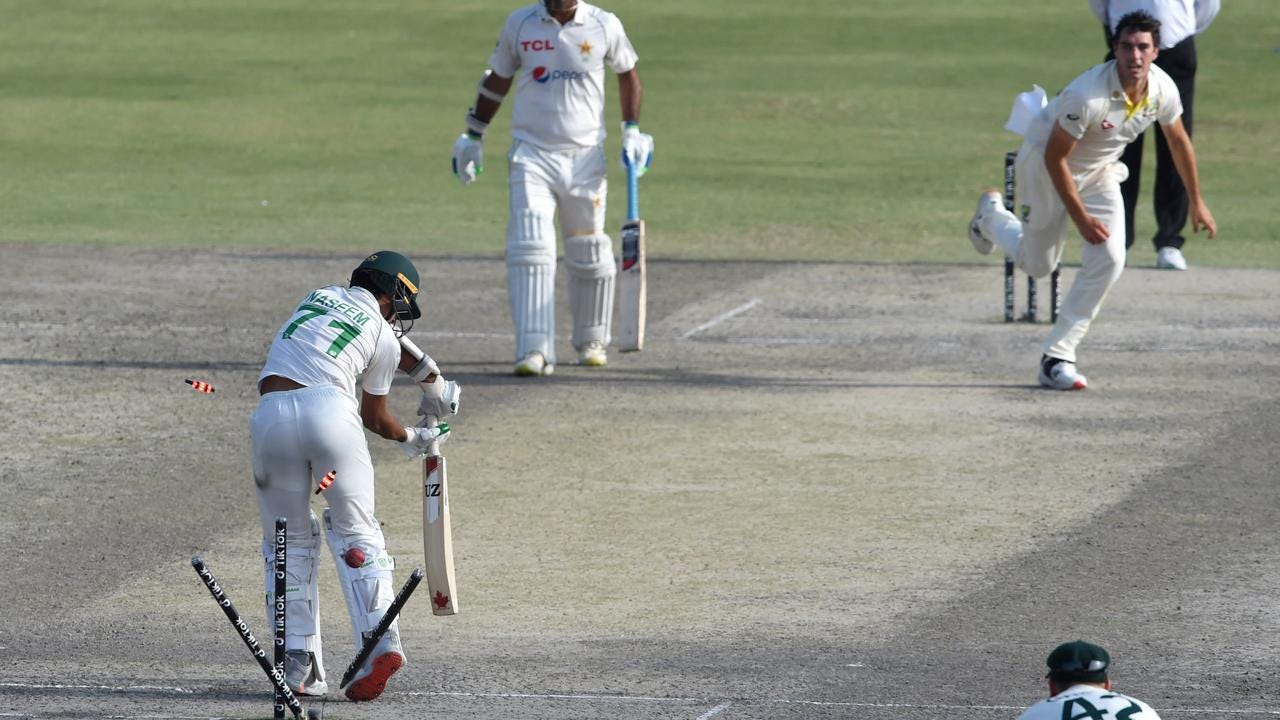The closest Ben Hogan came to disclosing the secret of his golf swing was to say, "The secret is in the dirt," alluding to the dirt that belonged to the driving range. Practice to Hogan was both a stimulant, and a sedative.
Hogan dug nine major championships out of the dirt during a seven-year stretch. This, from only 16 starts. He remained peerless through that post-war period, and remains revered today, by many.
Fast-forward nearly 70 years to a country that has only 48 golf courses, lots of dirt, and only 'Ben Hogans' in the making. Subha Bakher, Pakistan.
We will say sedatives held the advantage over stimulants in the first two Tests of this enthralling series, some 24 years in the making. Both, Pakistan and Australia, spent ample time in the unresponsive dirt of Rawalpindi and Karachi.
Finally, thankfully, the series came to a head in Lahore. And, Australia prevailed over a tireless host. This, in my opinion, was a 'fair dinkum' series win, one that should, and will, galvanise Australia, and one that consolidates Pakistan as a resilient foe.
The end came when Pat Cummins scattered Naseem Shah's wickets across the 'flat as a biscuit' Lahore wicket. Shah, left, looking like a left-hand batter, trapped in a right-handers body.
Pakistan were bowled out for 235 and Australia had won by 115 runs.
The final day started with Cummins, and his burgeoning coach, Andrew McDonald, unexpectedly allowing Cameron Green to take up the attack first, ahead of an in-form, Mitchell Starc.
Green responded, accounting for Abdullah Shafique, who, much to Steve Smith's solace, did not add to his overnight score of 27.
'Great things start from small beginnings.' Kudos to Cummins, Green and McDonald.
Nathan Lyon's contribution was immeasurable in his 108th Test. He made merry in the footholes outside the right-hand batsman's off-stump, exploiting continued variations in turn and bounce, finishing with 5-83 - putting out some of the fires from previous fourth-inning efforts.
Lyon accounted for Pakistan's elite batting triumvirate: opener, Imam-Ul-Haq (70), No. 3 batsman Azhar Ali (17) and captain Babar Azam (70).
Lyon, also, managed to cajole Mitchell Swepson through a thorough opening examination of his worth as a second spinner. Bowling leg-spin in the ear shot from Friday's 'call to prayer' is no easy task. Swepson will be more rounded for the experience.
Lyon's wicket support was provided by the captain; when Cummins re-arranged Shah's furniture, he had 3-23, propelling 15 second-innings overs, six of them maidens, and finishing with match figures of 8-79 from a combined 39 overs. A stellar effort.
On the flip-side of the ball, we must make mention of the imperious batting of Usman Khawaja.
Khawaja was rightfully awarded man of the series for his 496 runs at an average of 165. His batting initiated victory in Lahore, with a composed 91 in the first innings, and his second century of the series in the second. Allowing his team the time they needed to take the 10 second innings wickets.
Pakistan sits second in the ICC Test match rankings, blessed with accomplished batsmen and skilled bowlers; this was a series win to behold for Australia. Not once does my whiteboard have them not in front, in this game, and the series.
Pat Cummins' ascension to captaincy was not without question. Being a 'fast bowler' carries historical baggage, apparently. In my view, there is no logical argument. It just remains that 'fast bowlers' are unlikely to make astute captains? Much the same as questioning why a golf course has 18 holes.
I believe Cummins' nascent captaincy experience is exactly what this team required. His calmness, efficiency in rhetoric, and a youthful willingness to gamble when required, complement the team’s demographic perfectly.
Not the same can be said for the naysayers. The illuminati of Australian cricket sought to promote disruption, in a crisis they created. Criticism came from all angles.
Cummins was lambasted by past peers, and anyone who had come within cooee of replaced coach, Justin Langer. He was the 'ringleader' of 'player power' - the architect of Langer's demise.
The peripheral angst emanated from the same beings that delivered 'player power' to the Australian dressing room, previously.
Cummins countered eloquently: Just as you have always stuck up for your mates, I'm sticking up for mine." His 'mates' have his back.
Andrew McDonald, Langer's interim successor, has been paid little more than lip-service in correspondence since. Like Cummins, he has chosen his words carefully. Choosing to rely on action over talk, walking the walk.
A home series T20 win over Sri Lanka (4-1) - gave McDonald fresh air to breathe. The 'back-benchers' noise was dissipating. A progressive mindset is one of his core coaching strengths.
The rest of 2022 looked challenging for Australia, and McDonald; three Tests, three one-day internationals (ODI) and a T20 in Pakistan. Two Tests, then five ODIs and T20s in Sri Lanka through the middle of the year. And, then, their defence of the ICC T20 World Cup back in Australia.
2022 has started perfectly. Both Cummins and McDonald are strenuous protagonists of the 'process driven' movement. Neither of them are reactionary; both prefer to be almost liberal in their thinking. Fixing stuff ahead of time.
There also appears to be a steely resolve in both, which compliments their 'educate first' beliefs.
A stunning caught and bowled defined Cummins' resolve, with the first innings wicket altering the course of the game. Azhar Ali was meandering along without distraction, as was the game, then, in the blink of an eye, captain Cummins was pulling in the catch that would change the game, and shape the series win for Australia.
His coach, who would no doubt remain seated deep in thought, might just have registered a blip in his own flat-line heart-beat.
That was the moment Pat Cummins dug his own success out of the Lahore dirt.
And, Andrew McDonald edged closer to permanency in his role.






